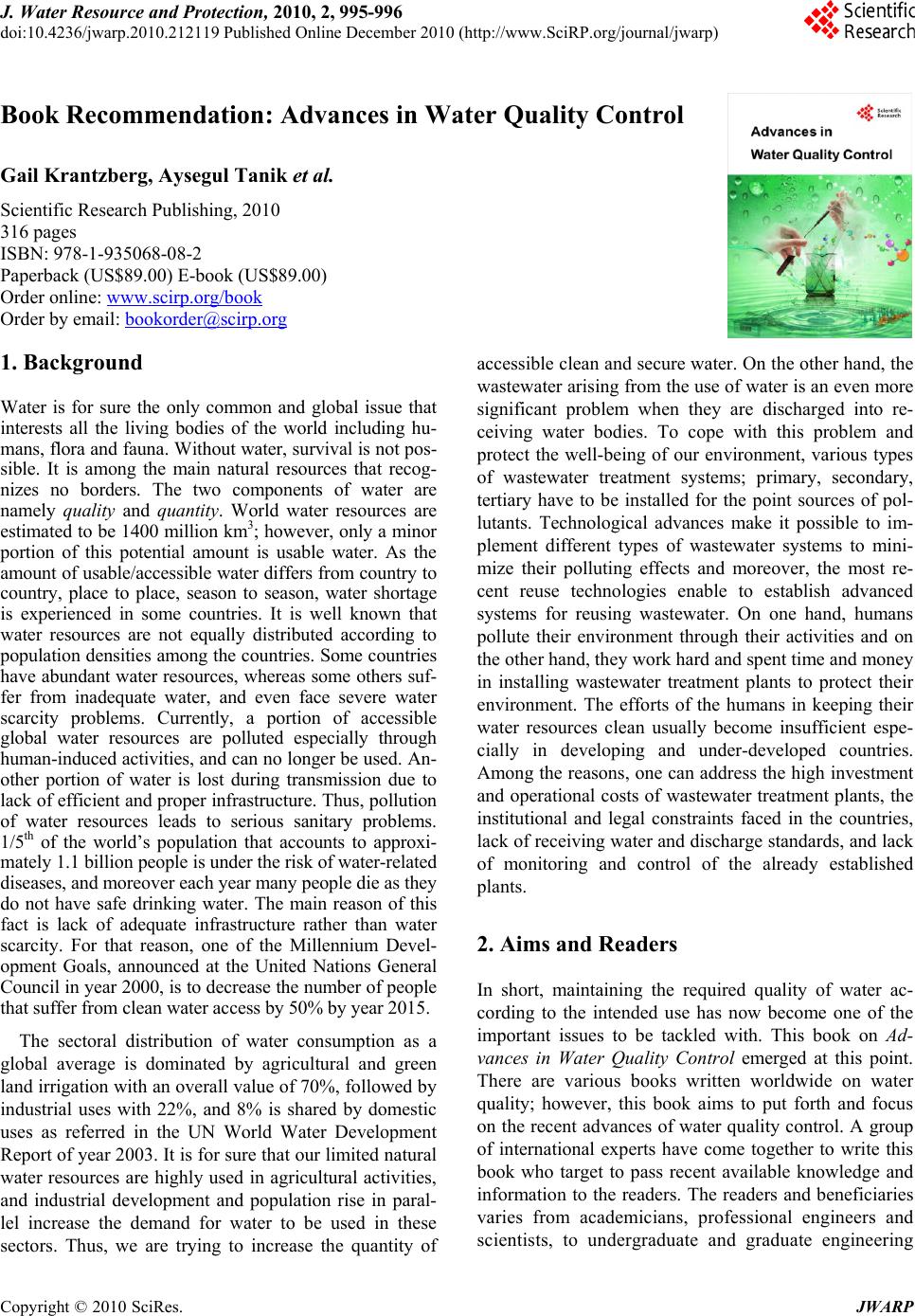
J. Water Resource and Protection, 2010, 2, 995-996
doi:10.4236/jwarp.2010.212119 Published Online December 2010 (http://www.SciRP.org/journal/jwarp)
Copyright © 2010 SciRes. JWARP
995
Book Recommendation: Advances in Water Quality Control
Gail Krantzberg, Aysegul Tanik et al.
Scientific Research Publishing, 2010
316 pages
ISBN: 978-1-935068-08-2
Paperback (US$89.00) E-book (US$89.00)
Order online: www.scirp.org/book
Order by email: bookorder@scirp.org
1. Background
Water is for sure the only common and global issue that
interests all the living bodies of the world including hu-
mans, flora and fauna. Without water, survival is not pos-
sible. It is among the main natural resources that recog-
nizes no borders. The two components of water are
namely quality and quantity . World water resources are
estimated to be 1400 million km3; however, only a minor
portion of this potential amount is usable water. As the
amount of usable/accessible water differs from country to
country, place to place, season to season, water shortage
is experienced in some countries. It is well known that
water resources are not equally distributed according to
population densities among the countries. Some countries
have abundant water resources, whereas some others suf-
fer from inadequate water, and even face severe water
scarcity problems. Currently, a portion of accessible
global water resources are polluted especially through
human-induced activities, and can no longer be used. An-
other portion of water is lost during transmission due to
lack of efficient and proper infrastructure. Thus, pollution
of water resources leads to serious sanitary problems.
1/5th of the world’s population that accounts to approxi-
mately 1.1 billion people is under the risk of water-related
diseases, and moreover each year many people die as they
do not have safe drinking water. The main reason of this
fact is lack of adequate infrastructure rather than water
scarcity. For that reason, one of the Millennium Devel-
opment Goals, announced at the United Nations General
Council in year 2000, is to decrease the number of people
that suffer from clean water access by 50% by year 2015.
The sectoral distribution of water consumption as a
global average is dominated by agricultural and green
land irrigation with an overall value of 70%, followed b y
industrial uses with 22%, and 8% is shared by domestic
uses as referred in the UN World Water Development
Report of year 2003. It is for sure that our limited natural
water resources are highly used in agricultural activities,
and industrial development and population rise in paral-
lel increase the demand for water to be used in these
sectors. Thus, we are trying to increase the quantity of
accessible clean and secure water. On the other hand, the
wastewater arising from the use of water is an even more
significant problem when they are discharged into re-
ceiving water bodies. To cope with this problem and
protect the well-being of our environment, various types
of wastewater treatment systems; primary, secondary,
tertiary have to be installed for the point sources of pol-
lutants. Technological advances make it possible to im-
plement different types of wastewater systems to mini-
mize their polluting effects and moreover, the most re-
cent reuse technologies enable to establish advanced
systems for reusing wastewater. On one hand, humans
pollute their environment through their activities and on
the other hand, they work hard and spent time and money
in installing wastewater treatment plants to protect their
environment. The efforts of the humans in keeping their
water resources clean usually become insufficient espe-
cially in developing and under-developed countries.
Among the reasons, one can address the high investment
and operational costs of wastewater treatment plants, the
institutional and legal constraints faced in the countries,
lack of receiving water and discharge standards, and lack
of monitoring and control of the already established
plants.
2. Aims and Readers
In short, maintaining the required quality of water ac-
cording to the intended use has now become one of the
important issues to be tackled with. This book on Ad-
vances in Water Quality Control emerged at this point.
There are various books written worldwide on water
quality; however, this book aims to put forth and focus
on the recent advances of water quality control. A group
of international experts have come together to write this
book who target to pass recent available knowledge and
information to the readers. The readers and beneficiaries
varies from academicians, professional engineers and
scientists, to undergraduate and graduate engineering